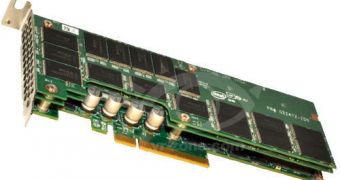Intel is almost ready to start selling a line of solid state drives based on 25nm HET-MLC NAND flash memory chips, a sort of blend between SLC and MLC NAND.
Granted, that isn't the correct way to put it. Rather, HET-MLC is a special kind of MLC (multi-level cell) NAND memory that has endurance levels closer to SLC (single-level cell), but a lower price.
The solid state drive series that VR-Zone says will soon surface is called SSD 910 and bears the “Ramsdale” codename.
Interestingly, this is both the first and the second line of SSDs to feature that moniker.
The first because Intel hasn't sold Ramsdale SSDs so far, but the second because the SSD 720 were also called Ramsdale but never made it to market.
At any rate, Intel's SSD 910 will have 400 GB and 800 GB capacities and will communicate directly with PCI Express slots.
In other words, they are PCI Express expansion cards loaded with HET-MLC NAND.
Three stacked PCBs (printed circuit boards) hold SSD subunits and the many, many flash chips, while the SAS interface manages the communication between said subunits and the core logic.
From there, the host communicates over the PCI Express 2.0 interface (x8) with the rest of the server, or whatever host system happens to house the storage device.
Moving on, the transfer speeds depend on the capacity: for the 400 GB drive, reading can go as high as 1 GB/s, while the writing speed is limited to 750 MB/s. The 800 GB SSD card attains 2 GB/s and 1 GB/s, respectively.
Finally, the random-access performance, which is even more important than sustained speeds in enterprise applications, is of 90,000 IOPS read / 38,000 IOPS write on the 400 GB and 180,000 IOPS read / 75,000 IOPS write on the 800 GB variant. As for write endurance, the former has 7 PB (petabytes) and the latter has 14 PB.

 14 DAY TRIAL //
14 DAY TRIAL //